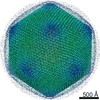[English] 日本語
 Yorodumi
Yorodumi- EMDB-30799: 9.4A reconstruction of Tokyovirus using 1,000 KV JEOL JEM-1000EES... -
+ Open data
Open data
- Basic information
Basic information
| Entry | Database: EMDB / ID: EMD-30799 | |||||||||
|---|---|---|---|---|---|---|---|---|---|---|
| Title | 9.4A reconstruction of Tokyovirus using 1,000 KV JEOL JEM-1000EES, varies from 7.7A reconstruction only by post-processing mask | |||||||||
 Map data Map data | 9.4A postproc map of Tokyovirus, acquired on a JEOL JEM-1000EES HVEM. Map differs from 7.7A and 8.7A map only by post-process mask applied (soft spherical) | |||||||||
 Sample Sample |
| |||||||||
| Biological species |  Tokyovirus A1 Tokyovirus A1 | |||||||||
| Method | single particle reconstruction / cryo EM / Resolution: 9.4 Å | |||||||||
 Authors Authors | Burton-Smith R / Murata K | |||||||||
| Funding support |  Japan, 1 items Japan, 1 items
| |||||||||
 Citation Citation |  Journal: Microscopy (Oxf) / Year: 2021 Journal: Microscopy (Oxf) / Year: 2021Title: Cryo-electron microscopy of the giant viruses. Authors: Raymond N Burton-Smith / Kazuyoshi Murata /  Abstract: High-resolution study of the giant viruses presents one of the latest challenges in cryo-electron microscopy (EM) of viruses. Too small for light microscopy but too large for easy study at high ...High-resolution study of the giant viruses presents one of the latest challenges in cryo-electron microscopy (EM) of viruses. Too small for light microscopy but too large for easy study at high resolution by EM, they range in size from ∼0.2 to 2 μm from high-symmetry icosahedral viruses, such as Paramecium burseria Chlorella virus 1, to asymmetric forms like Tupanvirus or Pithovirus. To attain high resolution, two strategies exist to study these large viruses by cryo-EM: first, increasing the acceleration voltage of the electron microscope to improve sample penetration and overcome the limitations imposed by electro-optical physics at lower voltages, and, second, the method of 'block-based reconstruction' pioneered by Michael G. Rossmann and his collaborators, which resolves the latter limitation through an elegant leveraging of high symmetry but cannot overcome sample penetration limitations. In addition, more recent advances in both computational capacity and image processing also yield assistance in studying the giant viruses. Especially, the inclusion of Ewald sphere correction can provide large improvements in attainable resolutions for 300 kV electron microscopes. Despite this, the study of giant viruses remains a significant challenge. | |||||||||
| History |
|
- Structure visualization
Structure visualization
| Movie |
 Movie viewer Movie viewer |
|---|---|
| Structure viewer | EM map:  SurfView SurfView Molmil Molmil Jmol/JSmol Jmol/JSmol |
| Supplemental images |
- Downloads & links
Downloads & links
-EMDB archive
| Map data |  emd_30799.map.gz emd_30799.map.gz | 5.9 GB |  EMDB map data format EMDB map data format | |
|---|---|---|---|---|
| Header (meta data) |  emd-30799-v30.xml emd-30799-v30.xml emd-30799.xml emd-30799.xml | 7.4 KB 7.4 KB | Display Display |  EMDB header EMDB header |
| FSC (resolution estimation) |  emd_30799_fsc.xml emd_30799_fsc.xml | 42.3 KB | Display |  FSC data file FSC data file |
| Images |  emd_30799.png emd_30799.png | 296 KB | ||
| Archive directory |  http://ftp.pdbj.org/pub/emdb/structures/EMD-30799 http://ftp.pdbj.org/pub/emdb/structures/EMD-30799 ftp://ftp.pdbj.org/pub/emdb/structures/EMD-30799 ftp://ftp.pdbj.org/pub/emdb/structures/EMD-30799 | HTTPS FTP |
-Validation report
| Summary document |  emd_30799_validation.pdf.gz emd_30799_validation.pdf.gz | 393.6 KB | Display |  EMDB validaton report EMDB validaton report |
|---|---|---|---|---|
| Full document |  emd_30799_full_validation.pdf.gz emd_30799_full_validation.pdf.gz | 393.2 KB | Display | |
| Data in XML |  emd_30799_validation.xml.gz emd_30799_validation.xml.gz | 27.2 KB | Display | |
| Data in CIF |  emd_30799_validation.cif.gz emd_30799_validation.cif.gz | 39.1 KB | Display | |
| Arichive directory |  https://ftp.pdbj.org/pub/emdb/validation_reports/EMD-30799 https://ftp.pdbj.org/pub/emdb/validation_reports/EMD-30799 ftp://ftp.pdbj.org/pub/emdb/validation_reports/EMD-30799 ftp://ftp.pdbj.org/pub/emdb/validation_reports/EMD-30799 | HTTPS FTP |
-Related structure data
| Related structure data | C: citing same article ( |
|---|---|
| Similar structure data |
- Links
Links
| EMDB pages |  EMDB (EBI/PDBe) / EMDB (EBI/PDBe) /  EMDataResource EMDataResource |
|---|
- Map
Map
| File |  Download / File: emd_30799.map.gz / Format: CCP4 / Size: 6.4 GB / Type: IMAGE STORED AS FLOATING POINT NUMBER (4 BYTES) Download / File: emd_30799.map.gz / Format: CCP4 / Size: 6.4 GB / Type: IMAGE STORED AS FLOATING POINT NUMBER (4 BYTES) | ||||||||||||||||||||||||||||||||||||||||||||||||||||||||||||
|---|---|---|---|---|---|---|---|---|---|---|---|---|---|---|---|---|---|---|---|---|---|---|---|---|---|---|---|---|---|---|---|---|---|---|---|---|---|---|---|---|---|---|---|---|---|---|---|---|---|---|---|---|---|---|---|---|---|---|---|---|---|
| Annotation | 9.4A postproc map of Tokyovirus, acquired on a JEOL JEM-1000EES HVEM. Map differs from 7.7A and 8.7A map only by post-process mask applied (soft spherical) | ||||||||||||||||||||||||||||||||||||||||||||||||||||||||||||
| Projections & slices | Image control
Images are generated by Spider. | ||||||||||||||||||||||||||||||||||||||||||||||||||||||||||||
| Voxel size | X=Y=Z: 2.912 Å | ||||||||||||||||||||||||||||||||||||||||||||||||||||||||||||
| Density |
| ||||||||||||||||||||||||||||||||||||||||||||||||||||||||||||
| Symmetry | Space group: 1 | ||||||||||||||||||||||||||||||||||||||||||||||||||||||||||||
| Details | EMDB XML:
CCP4 map header:
| ||||||||||||||||||||||||||||||||||||||||||||||||||||||||||||
-Supplemental data
- Sample components
Sample components
-Entire : Tokyovirus A1
| Entire | Name:  Tokyovirus A1 Tokyovirus A1 |
|---|---|
| Components |
|
-Supramolecule #1: Tokyovirus A1
| Supramolecule | Name: Tokyovirus A1 / type: virus / ID: 1 / Parent: 0 / NCBI-ID: 1826170 / Sci species name: Tokyovirus A1 / Virus type: VIRION / Virus isolate: OTHER / Virus enveloped: No / Virus empty: No |
|---|---|
| Host (natural) | Organism:  Acanthamoeba castellanii (eukaryote) Acanthamoeba castellanii (eukaryote) |
-Experimental details
-Structure determination
| Method | cryo EM |
|---|---|
 Processing Processing | single particle reconstruction |
| Aggregation state | particle |
- Sample preparation
Sample preparation
| Buffer | pH: 6.5 |
|---|---|
| Vitrification | Cryogen name: ETHANE |
- Electron microscopy
Electron microscopy
| Microscope | JEOL 1000EES |
|---|---|
| Details | Microscope used was actually JEOL JEM-1000EES, however this is currently not available in the list of Microscope models. |
| Image recording | Film or detector model: GATAN K2 IS (4k x 4k) / Average electron dose: 35.0 e/Å2 |
| Electron beam | Acceleration voltage: 1000 kV / Electron source: LAB6 |
| Electron optics | Illumination mode: FLOOD BEAM / Imaging mode: BRIGHT FIELD / Cs: 4.1 mm |
 Movie
Movie Controller
Controller


 UCSF Chimera
UCSF Chimera






 Z (Sec.)
Z (Sec.) Y (Row.)
Y (Row.) X (Col.)
X (Col.)






















